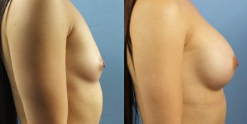Non-Surgical Rejuvenation
Consultations offered at our two convenient locations in Fairfield, CT and White Plains, NY

Non-surgical rejuvenation is treatment that provides long-lasting cosmetic results without the need for sutures or significant downtime. Many patients are looking for safer, less invasive solutions that won’t impact their day-to-day lives. In 2020, injectables such as neuromodulators and dermal fillers like Botox, Juvéderm, and Restylane were the most widely requested non-invasive treatments in the United States. (1) It is easy to see why they are so popular; they are relatively quick, require no anesthesia, and give patients the boost in self-confidence they are searching for.
After speaking with Dr. Alfred Sofer, a board-certified plastic surgeon with over 20 years of experience, you will get a comprehensive idea of which non-surgical methods can work best for addressing your needs. As an award-winning surgeon, Dr. Sofer has advanced knowledge of the art of these techniques and how to customize them to fit every patient’s unique facial features. To see the options he has available at his practices in White Plains, NY, call (203) 336-9862 or visit his contact page to request a consultation today.
Contents
About Neuromodulators
Dr. Sofer offers Botox, arguably the most well-known neuromodulator currently on the market. All cosmetic neuromodulators work by altering the functioning of the messenger chemical acetylcholine that aids muscle movement. It works to temporarily block this chemical from cellular receptors, stopping the muscle from contracting. When applied to the facial muscles in small amounts, the overlying skin smooths out, effectively eliminating wrinkles.
Botox is made of botulinum toxin, a protein that has numerous medical benefits and has been found to be effective treatment for a muscular eye disorder called strabismus, hyperhidrosis (excessive sweating), migraines, and more. (2) Dr. Sofer can use Botox on patients’ dynamic wrinkles– wrinkles that appear as a result of certain facial expressions- to prevent them from becoming static wrinkles that permanently remain on the face. If you have lines beginning to form in these areas, consider Botox injections as your primary prevention tool:
- Frown lines/ “11” lines
- Horizontal forehead lines
- Vertical neck bands
- Crow’s feet
About Dermal Fillers
Dermal fillers are quite different from neuromodulators since they promote healing and rejuvenation within the skin itself, and they do not affect facial muscles. Dr. Sofer offers hyaluronic acid-based fillers Restylane and Juvéderm, biocompatible, dissolvable, and hydrating fillers that have volumizing capabilities.
Since hyaluronic acid (HA) is already produced as a lubricating substance in the skin and joints, it works in harmony with your body- drawing in more water into the skin, binding to collagen, and providing structural support for the extracellular matrix, the area in between skin cells that provides nutrients. (3) The HA also stimulates the skin to create more fibroblast cells, ultimately resulting in a more youthful, glowing skin texture.
Dermal fillers can effectively treat:
- Laugh lines
- Vertical lip lines
- Lack of facial volume
- Under-eye hollowness
- Poor chin and jawline definition
- Other mild and moderate wrinkles
How Long Do Dermal Fillers Last?
Depending on the chosen Juvéderm or Restylane formulation and your metabolism, each variation of these fillers is expected to last for a certain amount of time:
- Juvéderm Voluma XC can be a great alternative to a chin augmentation. It lasts about 12 months in the chin and 24 months in the cheekbones.
- Juvéderm Volux XC for the jawline can last up to 18 months.
- All other Juvéderm formulations can last up to 1 year.
- Restylane formulations last 6 to 12 months.
While longevity is an important consideration when it comes to finding the right treatment, your specific treatment area and the extent of your facial aging are also critical factors that you can discuss with Dr. Sofer.
Personal Consultation
During your personal consultation with Dr. Sofer, he will help you decide which non-surgical treatment can provide the best outcome according to your aesthetic vision. As a highly competent surgeon, Dr. Sofer prioritizes safety, satisfaction, and natural-looking results that enhance patients’ appearances, not alter it.
If the benefits of these cosmetic treatments intrigue you, please reach out to his practice in White Plains, NY by dialing (203) 336-9862 to speak with a member of our staff. Alternatively, you can inquire with our online patient evaluation form, and we will get back to you promptly.
Preparation
Dr. Sofer advises all patients receiving injectable treatments to stop taking all medications and supplements that thin the blood at least 1 week before your scheduled appointment. You should also refrain from applying retinoid and retinol creams, removing hair from the treatment area, and sun exposure. Please let Dr. Sofer know if you have ever had a facial viral outbreak, so that he can prescribe the appropriate antiviral medication to prevent the likelihood of it returning due to the injections. Finally, immediately before Dr. Sofer administers your injections, you should consider applying an ice pack for a few minutes to reduce any unwanted post-procedural swelling or bruising.
Procedure Steps
Botox
Botox administration requires a thorough understanding of the intricacies of facial muscles. First, Dr. Sofer will cleanse your face and ask you to make a variety of facial expressions. While taking into consideration your cosmetic desires, he will mark out the locations of each injection. He will target the depressor muscles of the face, muscles that move downward. As these muscles receive a few units of Botox, they will relax and create a lifting effect to the overlying skin. He will keep in mind to use the optimal amount of Botox in each location to prevent the risk of producing unnatural looks. For example, the forehead area typically needs about 10 to 20 units, while more pronounced “11” lines could require more than 30 within one syringe. Due to the fact that the needles are incredibly thin, and there is lidocaine mixed with the medication, the procedure is tolerated well by most patients. Dr. Sofer usually finishes Botox procedures in 20 minutes or less.
Juvéderm and Restylane
Hyaluronic acid-based fillers are injected in a similar way except that Dr. Sofer will not ask you to make facial expressions. Unlike Botox, Juvéderm and Restylane are injected into the treatment area and lightly massaged to get the medication to evenly spread. These injections are more superficial than Botox since they only reach the dermis layer of the skin.
Aftercare and Results
If you choose Botox as your treatment of choice, you will need to follow specific aftercare instructions that will allow the medication to work properly. Firstly, Dr. Sofer will require that you keep your head elevated for a minimum of 4 hours. This ensures that the Botox does not travel to elevator muscles that can move the facial tissue downward. You should also refrain from exercising, applying ice, touching your face, and showering for at least 24 hours. Within a few days, your wrinkles will begin to relax and your final results will completely settle in. You should expect smoother, more revitalized skin for 3 to 4 months, then your body will fully metabolize the Botox. Though it works as a wrinkle-prevention tool, consider consulting Dr. Sofer on ways you can optimize your skincare routine to further prevent signs of aging.
Aftercare for dermal fillers is slightly different due to the nature of how fillers work within the skin. After receiving Juvéderm or Restylane, you can touch your face with clean hands to distribute the hyaluronic acid within the treatment area. Dr. Sofer will encourage you to use an ice pack to relieve any discomfort you may experience. To get the full benefits of the fillers, you should avoid applying makeup, exercising, sun exposure, and drinking alcohol for at least 24 hours after your appointment. Though you will notice immediate improvements in volume and a reduction in wrinkles, some of the residual swelling could take up to 2 weeks to fully go away. Fillers work over time as the production of your connective proteins increases, and results can last anywhere from 6 to 18 months, depending on the type of filler you choose.
Cost of Non-Surgical Rejuvenation in Fairfield, CT
The cost of your fillers and/or Botox will depend on your specific treatment plan, the formulation of dermal filler used, and any necessary follow-up appointments. Dr. Sofer is proud to provide cost-effective solutions that are affordable without compromising on quality or safety. We believe that everyone should have access to rejuvenation treatments that provide value for their money, which is why we offer several financing options. If you are still unsure about which procedure you would like to inquire about, please take a look at our blog to better inform yourself. We can’t wait to assist you on your journey toward renewed self-confidence.
FAQ
Can dermal fillers correct facial sagging?
Though fillers can’t correct sagging, lax skin, they can volumize other areas of the face in order to minimize its appearance.
Can I reverse the effects of dermal fillers or Botox?
Juvéderm, Restylane, and the effects of other hyaluronic acid fillers can be reversed with an enzyme called hyaluronidase. The results of Botox, on the other hand, can’t be reversed and you will have to wait until your body metabolizes the medication.
Do dermal fillers and Botox produce natural-looking results?
When applied by a highly trained professional with a thorough knowledge of how these treatments work in relation to facial anatomy, results can look very natural. The goal with these non-surgical methods is to enhance features that are already present and provide more subtle, youthful characteristics. The results are meant to present the best aspects of your natural beauty.
References
- American Society of Plastic Surgeons. 2020 Plastic Surgery Statistics Report. 2020. https://www.plasticsurgery.org/documents/News/Statistics/2020/plastic-surgery-statistics-report-2020.pdf
- Padda IS, Tadi P. Botulinum Toxin. PubMed. Published 2022. https://www.ncbi.nlm.nih.gov/books/NBK557387/#:~:text=Botulinum%20toxin%20is%20a%20medication
- Dong, Qin, et al. “Understanding Hyaluronic Acid Induced Variation of Water Structure by Near-Infrared Spectroscopy.” Scientific Reports, vol. 10, 28 Jan. 2020, p. 1387, www.ncbi.nlm.nih.gov/pmc/articles/PMC6987104/, https://doi.org/10.1038/s41598-020-58417-5.

